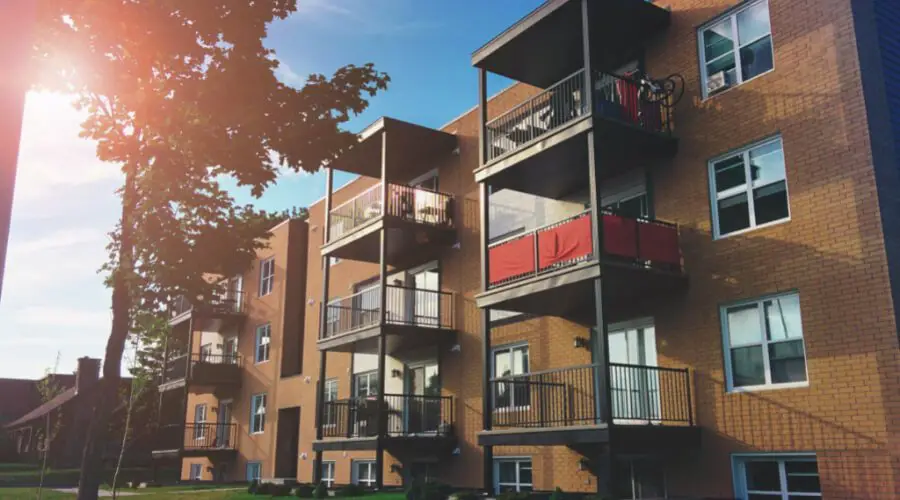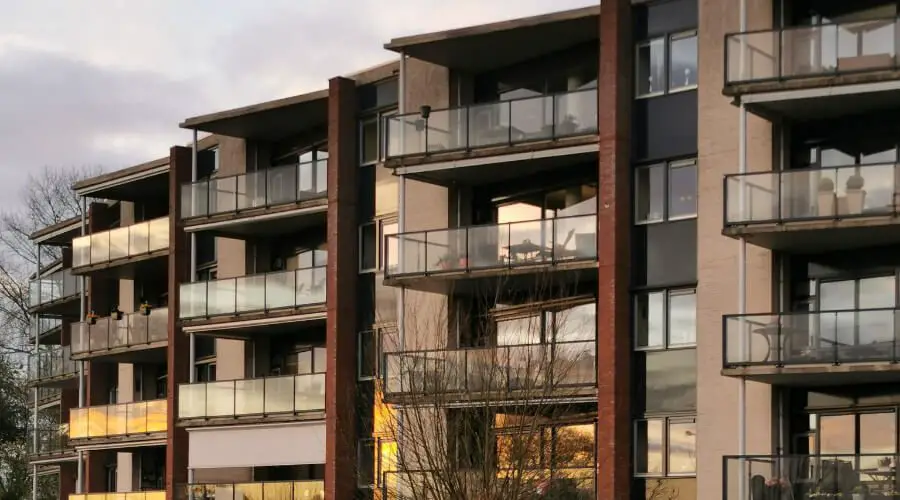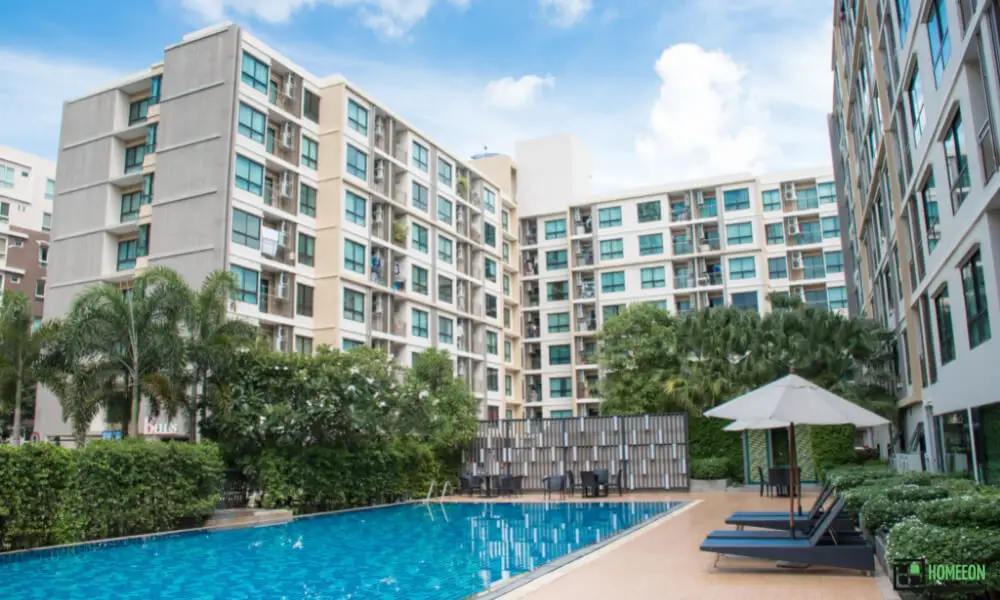Last Updated on July 18, 2023 By Emma W. Thomas
The main difference between an apartment-flat complex and an apartment building lies in their architectural layout and scale. An apartment-flat complex typically refers to a collection of individual units on the same level, often with their own separate entrances, forming a cluster of flats or apartments. On the other hand, an apartment building typically consists of multiple floors or stories, with several apartments stacked vertically, sharing common hallways, staircases, and elevators.
Apartment Complex VS Apartment Building: Five Differences Explained

An apartment complex is more than just a building; it comprises features and amenities that make living more comfortable and pleasant. On the other hand, apartment buildings are basic living units that are self-contained and ideal for functional living. If you want to rent a house where you can socialize and make friends with your neighbors, then an apartment complex is the most ideal for you. If you are looking for living space without having much interest in social amenities and other public utilities, you will be comfortable living in an apartment building. Let’s look at the differences between an apartment complex and an apartment building in detail:
1. Features And Amenities
The most significant difference between an apartment complex and a building is the features and amenities included outside the living space. An apartment building has living spaces of different sizes and price ranges. Some apartment buildings accommodate studio apartments, one-bedroom, and two-bedroom houses. Here are some unique features associated with apartment complexes:
a. Parking Spaces
Unlike Apartment buildings, apartment complexes have designated parking spaces for each tenant. When you move into a complex, you will be assigned a parking spot with a number to make it easier to identify your spot. The main advantage of living in an apartment complex is that you won’t have to pay additional fees for parking. In most urban areas, those living in apartment buildings have to pay extra parking fees.
b. Leasing Office
The leasing office is your property manager’s office, and all administrative tasks are done there. Any important documents, including leases, maintenance requests, and invoices, are found here. When you rent a house in an apartment complex, you will have the advantage of reaching your property manager at any time. The leasing office is usually located elsewhere and not where you live for apartment buildings.
c. Street Lights
Apartment complexes have street lights that light up the parking and walkways at night to guarantee the safety of residents. For apartment buildings, the streets and streetlights are managed by the local government and not the apartment owners.
2. Social Amenities
Apartment complexes have social amenities that make interacting with neighbors easier and make the neighborhood feel more at home. When living in an apartment complex, you will know your neighbors and feel like part of a community. Below are some of the amenities that you will find in most apartment complexes
a. Fitness center
Most complexes have a fitness center with all the equipment you need, including weights, treadmills, and stationary bikes. You will pay extra to access the fitness center in some places, but this amount is significantly cheaper than a gym membership. A fitness center will enable you to interact with your neighbors and cut your time driving to the gym.
b. Swimming Pool
A swimming pool is standard in all apartment complexes; you can host barbeques, interact with neighbors, and even host parties at the pool.
C. Lounge Or Clubhouse
Most upscale apartment complexes have a clubhouse or a lounge where large groups can relax and have meetings. These spaces have Wi-Fi, a pool, darts, and a TV; residents can host parties in these spaces with permission from management.
3. Costs
Apartment complexes come with additional charges on top of rent and utilities used to maintain the extra amenities. Since you won’t pay for parking, gym memberships, and swimming, the management company will charge you a small amount to cater for maintenance. The maintenance charge is a constant amount and will be indicated in your lease agreement. You will only need to pay for apartment buildings’ rent and utility bills. In some apartment buildings, utilities are included in the rent, and you will only need to pay rent. If you are on a tight budget, apartment buildings will be a better choice for you.
4. Ownership
Another difference between an apartment complex and an apartment building is who owns it. Most apartment complexes have several owners but one management company. You will find that every unit or floor has a different owner. On the other hand, apartment buildings are mostly owned by one person or company.
5. Number Of Units
Apartment complexes are comprised of many apartment buildings and the buildings hosting amenities. More living units and more neighbors will be in apartment complexes than in apartment buildings. The economies of scale of apartment complexes allow them to have shared amenities at little or no extra cost.
What is Apartment-Flat Complex?
An apartment-flat complex refers to a residential housing arrangement where multiple individual apartments or flats are grouped together in a relatively horizontal layout. Each apartment in the complex typically has its own separate entrance, making it more akin to a row of individual units.
The apartments can be located on the ground floor, or there might be a few stories, but they are usually not stacked vertically like in a traditional apartment building. Apartment-flat complexes are often designed with a more community-oriented feel and may offer shared outdoor spaces or amenities for the residents to enjoy.
What is Apartment Building?
An apartment building is a multi-story residential structure designed to accommodate multiple individual apartments or flats on different floors. It is a vertical arrangement, with apartments stacked one above the other, typically accessed through common hallways, staircases, and elevators. Apartment buildings can vary in size and scale, ranging from small buildings with just a few units to large high-rise complexes with numerous apartments.
They are a common form of urban housing, offering residents the convenience of living in close proximity to amenities and services. Apartment buildings may also provide shared facilities such as gyms, rooftop terraces, or communal areas for socializing.
Pros and Cons of Apartment-Flat Complex
Pros of Apartment-Flat Complex:
- Community Atmosphere: The horizontal layout fosters a closer sense of community among residents, promoting social interactions and neighborly relationships.
- Privacy: Each apartment has its own separate entrance, offering more privacy compared to traditional apartment buildings with shared hallways.
- Outdoor Space: Apartment-flat complexes often have shared outdoor spaces like gardens or courtyards, providing residents with places to relax and enjoy the outdoors.
- Easy Access: Ground-floor units eliminate the need for stairs or elevators, making it convenient for individuals with mobility challenges.
- Fewer Shared Amenities: Smaller complexes may have fewer shared amenities, reducing maintenance costs and potentially lowering rent.
Cons of Apartment-Flat Complex:
- Limited Floor Space: The horizontal layout may limit the number of units, making it less suitable for larger housing communities.
- Less Vertical Expansion: Unlike high-rise apartment buildings, apartment-flat complexes might not allow for vertical expansion to accommodate population growth.
- Parking Challenges: Horizontal layouts might have limited parking spaces, leading to potential parking issues for residents and visitors.
- Noise and Privacy: Ground-floor units could be more susceptible to noise from common areas, potentially impacting privacy.
- Accessibility: Residents on higher floors might face accessibility challenges, especially without elevator access.
Pros and Cons of Apartment Building
Pros of Apartment Building:
- Vertical Space Utilization: Apartment buildings can accommodate a larger number of units in a smaller footprint, making them suitable for denser urban areas with limited land availability.
- Shared Amenities: Many apartment buildings offer shared amenities like gyms, pools, rooftop terraces, and communal spaces, providing residents with added convenience and recreational opportunities.
- Elevator Access: High-rise apartment buildings with elevators offer easy access to upper floors, making it more convenient for residents, especially those with mobility challenges.
- Security: Apartment buildings often have controlled access points and security features, providing a sense of safety for residents.
- Potential for Growth: Large apartment buildings can be expanded vertically, accommodating increasing populations in urban centers.
Cons of Apartment Building:
- Limited Privacy: Shared hallways and elevators may reduce privacy compared to apartment-flat complexes with separate entrances.
- Noise Concerns: High-density living can lead to increased noise levels from neighboring units or common areas.
- Maintenance Costs: The maintenance of shared amenities and larger building structures can result in higher maintenance costs and potentially higher rent for residents.
- Community Size: In larger apartment buildings, the sense of community and neighborly interactions might be less pronounced than in smaller complexes.
- Elevator Dependency: Elevator breakdowns or maintenance can inconvenience residents, especially those living on higher floors.
Apartment Complex VS Building: Which One Should You Rent?

There’s not much difference between an apartment complex and an apartment building regarding the living space. When deciding which one to rent, you will need to consider factors such as your lifestyle needs, budget, and what amenities are a must-have for you. If you are on a tight budget, an apartment building might be the most cost-effective option for you. Look for a unit whose utility bills are included in the rent.
If you have a flexible budget, you can rent a unit in an apartment complex to allow yourself the luxury of enjoying the extra amenities. Living in an apartment complex is also a great idea to make new friends and socialize. Since you have social amenities, you are likely to meet people of your social class with the same interests. When living in an apartment complex, you will have access to the fitness center and lounge at any time. You will save your time driving to the gym and money spent on gym memberships.
What Are The Types Of Apartment Buildings?
Apartment buildings are available in different styles and structures. Every structure has a different name, and all these terms can get confusing when you don’t know how t differentiate them. This section looks at the different types of apartment buildings to help you understand what to expect in each.
1. Duplex
A duplex is a building with two living units attached; the design of the duplex varies from building to building. Some are designed above each other, while others are next.
2. Condominium
Condominiums, commonly referred to as condos, are structures consisting of several individually owned units with common areas that are jointly owned. Condominiums are outrightly owned and not leased by occupants.
3. Studio Apartment
A studio apartment is a self-contained living space with all the functional areas combined into a single room. In a studio apartment, you will find designated space for the living room, kitchen, bedroom, and washroom.
4. Townhouse
A townhouse is a unit designed to mimic a detached or semi-detached home in a multi-unit complex. Townhouses are different from apartments because they have multiple floors and an outside door for each unit.
5. Micro apartment
Micro-apartments are living units mostly found in urban centers to provide low-cost but functional accommodation. You can find a micro-apartment sitting on 45 square feet that accommodates a sitting space, sleeping space, kitchenette, and bathroom. Residents of such units usually have access to a communal bathroom or kitchen.
Final Word
When looking for living space to rent, you will encounter numerous terms that seem similar and can be confusing for first-time renters. Apartment complex and apartment building is one such term. Before house hunting, you will need to research to avoid wasting time visiting apartments that don’t match your needs. Another term that confuses most people is the difference between a flat and an apartment. These two are different, but a flat is mostly in British English while an apartment is in American English. In most areas, apartments are high-end and luxurious living, while flats are middle-class residential areas. We hope this article has helped you understand the difference between an apartment complex and an apartment building. From now on, you will be in a better position to understand different terms used in real estate and differentiate them.
References:
https://www.apartmentlist.com/renter-life/apartment-complex-vs-building
https://www.quora.com/What-is-the-difference-between-an-apartment-complex-and-apartment-building
Emma is a graduate of Domestic Science or Family and Consumer Sciences (Home Economics) from the University of Wisconsin. She has 7 years of experience Working with the strategic section of BestBuy and now writing full-time for Homeeon.
From Managing the Home, Interiors, Cleaning, and Exteriors to Gardening and everything about Making A Home Liveable – is her passion and this Homeeon is the result of this.
Emma loves decorating her home with the best stuff found online. She cares about quality over anything and writes reviews about them here in Homeeon. Get in touch with her over Pinterest.
Keep reading her blogs.

